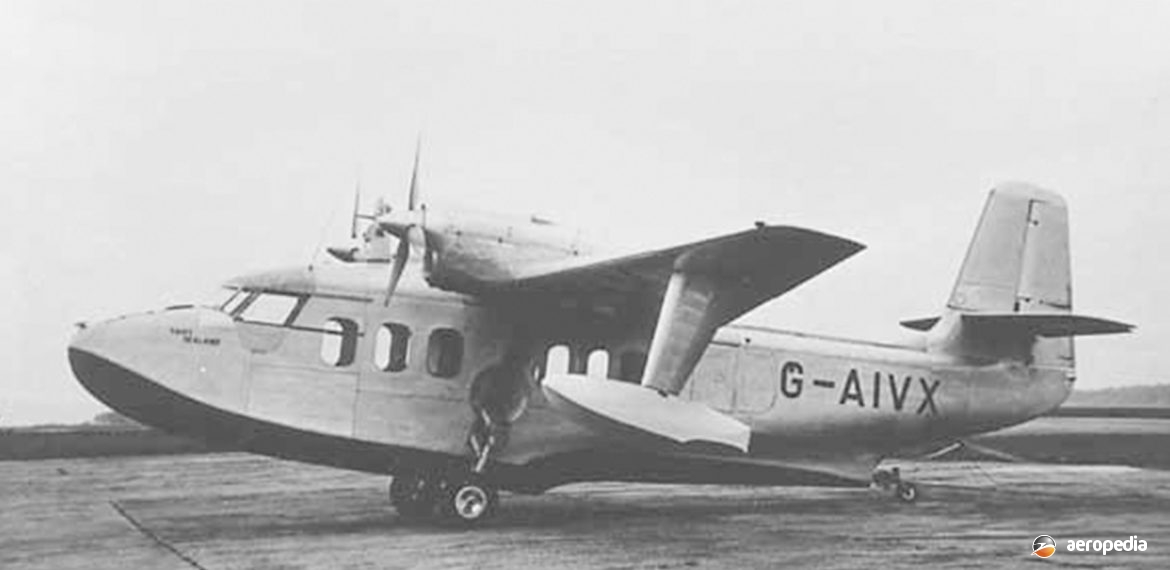Photograph:
Short Sealand JZ-PTA (c/n CH.1769 ) of Christian & Missionary Alliance at Eidenberg, Irian Jaya in the late 1950s (Author’s Collection)
Country of origin:
United Kingdom
Description:
Commercial flying boat
Power Plant:
Two 254 kw (340 hp) de Havilland Gipsy Queen 70-3 six-cylinder inverted in-line geared and supercharged air-cooled engines
Specifications:
- Wingspan: 18.74 m (61 ft 6 in)
- Length: 12.86 m (42 ft 2 in)
- Height: 4.57 m (15 ft)
- Wing area: 33.35 m² (359 sq ft)
- Max speed: 301 km/h (187 mph)
- Cruising speed: 272 km/h (169 mph)
- Ceiling: 6,400 m (21,000 ft)
- Rate of climb: 268 m/m (880 ft/min)
- Take-off run on water: 763 m (2,505 ft)
- Range: 797 km (495 miles)
- Empty weight: 3,178 kg (7,007 lb)
- Loaded weight: 4,128 kg (9,100 lb)
History:
The Sealand series was designed by Short Brothers & Harland of Belfast, Northern Ireland, as a completely new flying-boat shortly after World War II, being a five to eight seat amphibian powered by two Gipsy Queen 71 engines. A total of 25 examples was completed, ten of these serving with the Indian Navy. The prototype (G-AIVX – c/n SH.1555), a Model 1H, flew for the first time at Belfast on 22 January 1948 and was followed by a further demonstrator (G-AKLM – c/n SH.1562).
Short Brothers considered a market existed for a range of commercial flying-boats designed for their purpose rather than a conversion of an existing military design. Three designs were proposed, the SA.6, SA.7 and SA.8 but only the SA.6 was built. Work on the prototype was shared between the Company’s facilities at Rochester in Kent in the UK and Belfast. Early test flights revealed problems. The engines were lowered to reduce drag and the vertical tail surfaces were modified.
The Sealand was a high-wing cantilever monoplane with two engines, a single fin and rudder, and wing-mounted stabilising floats. It had a retractable tailwheel undercarriage. The wing was a modified Gottingen 436 aerofoil built in three parts and had TKS leading-edge de-icing boots. The hull was of near rectangular section of all-metal construction with Alclad stressed skin flush riveted on the planing bottom. The mainwheels swung up into the hull sides. The tailplane was all-metal with a two-spar structure. The height of the fin was later raised and the chord of the rudder was increased.
Production aircraft were fitted with two de Havilland Gipsy Queen 70-3 or 70-4 six-cylinder inverted in-line air-cooled engines which were geared and supercharged and drove de Havilland three-blade feathering and reversing propellers. The performance of the aircraft was reasonably successful but it was found to be underpowered and had some initial aerodynamic problems. Short Brothers considered the development of the SB.2 Sealand II to be fitted with 388 kw (520 hp) Alvis Leonides LE.4M nine-cylinder geared and supercharged air-cooled radial engines and a mock-up of this model was built but the prototype was never completed in that form. The prototype of this model was later completed as G-AKLM (c/n SH.1562) and took part in the King’s Cup race on 28 July 1949. It later went on a sale tour of Scandinavia but crashed in Norway. An extensive sales tour of north and south America, and Europe, was made but sales were disappointing.
All aircraft built were SA.6 Mk 1s but two of the aircraft supplied to Norway were converted to all flying-boat configuration and redesignated SB.7 Sealand Mk III. Test pilots at the Marine Aircraft Experimental Establishment made a number of criticisms as to the performance and handling and wingtip slats were fitted, the hull was modified to increase buoyancy and the wingspan was increased by 0.762 m (2 ft 6 in). The noted British journalist John Stroud stated in 1993 “the Sealand could not be considered a commercial success” but “it was, however, pleasant to fly and in Norway it served VLS well until the building of Bergen Airport.”
Two examples of the Sealand have operated in this part of the world, both by the Christian & Missionary Alliance of Djakarta, operating in Irian Jaya, formerly the Dutch East Indies and now part of Indonesia. The first of these was JZ-PTA (c/n CH.1769 ), a Mk 1C which crashed and was destroyed on 28 April 1955. The aircraft was on a flight from Eidenberg to Baliem in Central Papua, crashing into a mountainside, and the pilot, the only person on board, was killed.
A further aircraft was obtained, an SA.6 Sealand 1C, which became PK-CMA (c/n SH.1568 – ex G-AKLT). It flew for the first time on 21 November 1953 and was delivered on 28 November 1953. It was written off in a forced landing in a thunderstorm in Java in 1953.
Three examples of the Sealand survive but none is airworthy: G-AKLW (ex SU-AHY – c/n SH.1571), which operated for a period in Egypt, is with the Ulsterfolk & Transport Museum in Belfast, Ireland; 6662 (c/n SH.1567 – ex YU-CFK, G-AKLS) in the Yugoslav Aeronautical Museum in Belgrade, Serbia; and IN-106 (c/n SH.1763), a former Indian Air Force machine, in the National Aviation Museum in Goa, India.

